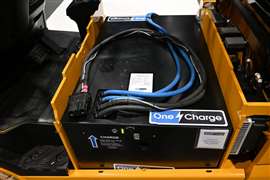BMS quality dictates battery pack longevity
04 September 2023

Battery management systems (BMS) play a pivotal role in supporting the extended cycle life of a battery pack. The BMS regulates and optimizes the charging and discharging processes, equalizing the performance of individual cells and preventing overcharging or deep discharging that can lead to capacity degradation or even safety hazards.
Additionally, the BMS monitors and maintains a suitable temperature range inside the battery pack, mitigating the risk of thermal runaway and ensuring optimized operation.
A generic BMS can lack the sophistication needed to support specific battery chemistries and equipment applications. As a result, batteries paired with an off-the-shelf BMS may suffer from compromised cell performance, reduced capacity and a shorter lifespan. Additionally, safety concerns escalate as these rudimentary BMSs may struggle to detect and manage potential issues, increasing the likelihood of failures.
 Maxim Khabur, OneCharge
Maxim Khabur, OneCharge
In essence, the BMS acts as a guardian, helping to preserve seamless battery performance and eliminate potential problems. Its intricate orchestration of charging, discharging, communication, and temperature control not only ensures efficient operation, but also safeguards against premature wear and safety hazards, making it an indispensable battery technology.
Cell chemistry
The chemistry of a cell establishes the upper threshold for a battery’s cycle life. Two prominent contenders are lithium iron phosphate (LFP) and lithium nickel manganese cobalt oxide (NMC), along with traditional lead-acid batteries.
Traditional flooded lead-acid batteries deliver around 1500 cycles before they lose capacity and can no longer maintain a charge. LFP and NMC battery cells promise anywhere from 3000 to 7000 cycles. While NMC batteries offer higher energy density and a slightly higher voltage, LFP batteries excel in longevity.
But battery chemistry alone does not dictate cycle life; engineering design plays an equally crucial role. For example, in laboratory conditions an LFP battery can outperform an NMC equivalent at pack level, with the NMC cells demonstrating higher numbers both in longevity and energy density.
This is achieved by using a pack design which can mitigate the impact of extreme temperature, uneven cell aging and stress-induced degradation. Moreover, a well-engineered battery system with robust thermal management, efficient current distribution and optimal electrode configurations will extend the number of warrantied cycles and deliver years of service.
Holistic approach
Modern industrial batteries are complex devices and like any equipment using such advanced technology, they require professional support. The process begins with a pre-delivery inspection (PDI) of the battery packs, where expert guidance ensures seamless integration between the charging unit and host vehicle. The correct settings guarantee optimal performance and minimize potential glitches.
 OneCharge lithium battery installed in a Hyundai forklift
OneCharge lithium battery installed in a Hyundai forklift
The data capabilities of modern li-ion batteries support predictive maintenance, which not only helps to safeguard against failures but also extends battery life. Reliable data collection mechanisms help to troubleshoot the battery pack remotely, which in turn supports timely intervention to avoid breakdowns and downtime – while also optimizing working performance.
A trained technician can usually resolve most common battery performance problems in minutes. This is why battery manufacturers invest in training programs for their partners. A few hours spent on training may save days of downtime and dramatically improve equipment utilization.
Armed with insights into real-time battery health and performance metrics, machine managers can make calculated choices to enhance efficiency and minimize operational disruptions. At the base of this data-centric paradigm lies the accurate logging of battery specifications. With automated recording and updating of the model codes and working parameters of all battery components, technicians can make sure any issue with battery charging or performance can be efficiently diagnosed and resolved.
Maintaining the battery in peak condition all comes back to the BMS. While cell chemistry sets the limit for lifetime battery charge/discharge cycles, this engineering plays a significant role in achieving the battery’s warrantied service lifetime.
A comprehensive product lifecycle infrastructure, including professional support, regular service and data collection helps to enhance battery life. Data from the BMS helps with understanding and addressing these factors, ultimately allowing users to unlock the full potential of their lithium batteries.
Maxim Khabur is director of Marketing at OneCharge, a US-based manufacturer of industrial lithium-ion batteries. He is also a chairman of the Advanced Energy Council, which represents various companies and members of the Materials Handling Industry Association.
STAY CONNECTED




Receive the information you need when you need it through our world-leading magazines, newsletters and daily briefings.
POWER SOURCING GUIDE
The trusted reference and buyer’s guide for 83 years
The original “desktop search engine,” guiding nearly 10,000 users in more than 90 countries it is the primary reference for specifications and details on all the components that go into engine systems.
Visit Now
CONNECT WITH THE TEAM










